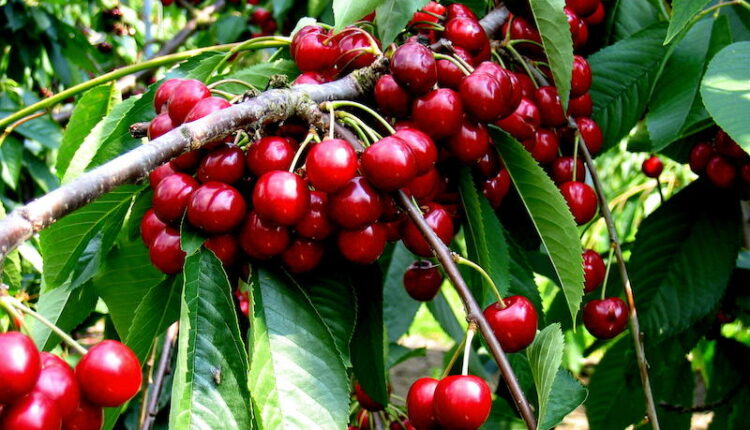©2021 Reporters Post24. All Rights Reserved.
Harvesting cherries from a homegrown cherry tree is next-level gardening. This striking tree also enhances your garden year-round with beautiful spring blooms, vibrant summer foliage, and stunning fall colors ranging from gold to red. Additionally, its bark can showcase interesting hues from coppery to reddish-brown.
Cherry trees not only beautify your landscape but also support pollinators and boost biodiversity. To fully enjoy their benefits, it’s important to learn proper care techniques. Ahead, experts highlight how to cultivate a cherry tree and offer essential tips for nurturing it throughout the seasons to ensure a healthy, bountiful harvest.
Key Points
- Cherry trees offer beauty in every season, support local wildlife, and reward you with tasty fruit year after year.
- Plant cherry trees in early spring or late fall in full sun and well-drained soil to encourage strong root growth.
- Select the right tree for your area, water it regularly, and prune it annually to cultivate healthy, productive trees.
- Dwarf cherry trees grow well in pots, but need repotting, winter protection, and lots of sunlight to thrive.
When to Plant a Cherry Tree
The best time to plant a cherry tree is in early spring or late fall when temperatures are cool enough to avoid transplant shock but warm enough for root establishment, says Chris Medeiros, general manager at Meena Farms. Cooler temperatures and moist soil conditions during these periods promote strong root development, supporting successful and continued growth.
Selecting the Right Cherry Tree Variety
When selecting a cherry tree variety for your backyard, Mark and Ellen Parlee, owners of Parlee Farms, recommend choosing a self-fertile variety, especially if you plan to grow one tree. This means the tree will pollinate itself and doesn’t need another tree for cross-pollination. The Parlees also recommend selecting a variety that is well-suited to your climate. Contact your local cooperative extension or local nursery for insight on the best variety for your growing zone.
That said, cherry trees can be broadly classified into two categories—pie cherries and sweet cherries.
- Pie cherries (Prunus cerasus): “These cherries are sour and tart and mostly used for pies and other cooking applications,” says Jacob Mentlik, nursery manager and orchardist for the tree division at Fedco Seeds Inc.
- Sweet cherries (Prunus avium): In contrast, sweet cherries are sweet, juicy, and great for fresh eating.
How to Plant a Cherry Tree
With the right location and suitable variety for your growing zone, planting a cherry tree can be an easy task. Follow these straightforward tips from Medeiros for successful planting.
- Select a location with full sun and well-draining soil. Ensure the area has deep, loose soil for healthy root expansion.
- Dig a hole twice as wide and just as deep as the tree’s root ball.
- Prepare a 4- to 6-inch mound to avoid trees sitting in pooled water.
- Place the tree gently in the hole, spreading the roots over the mound. The grafting union should be 2 to 3 inches above the soil line.
- Backfill with native soil, tamping gently to remove air pockets.
- Water thoroughly to help the soil settle. Avoid overwatering in the early stages of planting, as excessive watering can cause plant death.
- Apply mulch around the base, but not against the trunk, to retain moisture and discourage weeds.
- If necessary, stake the tree for support, especially in areas prone to windy conditions.
Avoid areas exposed to harsh winds and low-lying areas that experience freezing spring temperatures.
How to Care for a Cherry Tree
Now that your cherry tree is successfully planted, follow these easy care tips to ensure a healthy and productive tree.
Sunlight
Cherry trees require at least six to eight hours of direct sunlight per day, as full sun locations are ideal for optimum growth and production.
Soil
Cherry trees prefer well-drained, loamy, fertile, and slightly acidic soil with a pH of 6.0 to 7.0.
Water
Newly planted cherry trees require consistent watering to thrive. Water them deeply twice a week for the first few months after planting. Water established trees once a week, watering more during hot, dry spells.
Temperature
Most cherry trees thrive in temperatures ranging from 68 degrees Fahrenheit to 86 degrees Fahrenheit.
Fertilizer
A soil test is recommended to identify specific nutrient requirements. You can obtain a soil test kit from your local Cooperative Extension office. Depending on the results of your test, fertilize annually, once in April and again in May.
How to Prune a Cherry Tree
Pruning is done in the spring, once the severe cold has passed, but before the tree comes out of dormancy, according to the Parlees. “Pruning any fruit tree is critical for plant health and production,” they say. Pruning helps keep the tree stimulated and removes dead wood that could harbor pests. Here are two ways to ensure a properly pruned cherry tree.
The Central Leader Method:
A popular method for homeowners is the central leader method. This method features a central leader branch, and pruning is done to create a pyramid or Christmas tree shape. The Parlees note that it can take three to four years of pruning to achieve this shape; however, once the shape is established, the maintenance becomes more manageable.
- Identify the strongest and upright shoot as the central leader. Remove any other branches competing with this leader.
- Scaffold branches are the primary, permanent branches that form the framework of your tree. Select three to four side branches that are evenly spaced around the trunk of the tree.
- Cut back the selected scaffold branches to about one-third of their length. Cut above an outward-facing bud to encourage outward-facing new growth.
- Remove any branches that cross or extend inward, as well as those that are too close to the ground.
- Prune the central leader annually by removing any competing shoots and allowing for good airflow.
The Bud Thinning Method
Cherry trees can naturally produce a heavy set of fruit, which can lead to limb breakage and smaller cherries, which is why it’s essential to practice bud thinning. The Parlees explain that it can take four to seven years for fruit to set fruit so you have some time to learn how to properly thin buds.
“Once the tree begins bearing, the fruit load must be balanced to prevent bi-annual bearing,” the Parlees say, noting the tree will naturally drop some of the crop, so don’t be alarmed when that happens. “Additional hand-pruning may be needed to achieve the right balance for a yearly fruit harvest.”
Thin your cherry tree in the spring, typically early April. However, you can thin later-fruiting varieties up to mid-May. To thin the buds, carefully pinch or twist off the buds you have chosen to remove.
- Thin areas where the fruit clusters are overcrowded to help prevent limb breakage in the future.
- Remove buds that appear damaged, diseased, or smaller in size compared to the rest of the buds.
Growing a Cherry Tree in a Container
Cherry trees can grow up to 60 feet tall, so if you’re planning on cultivating your cherry tree in a pot, it’s best to choose a tree on a dwarf rootstock. “This will keep the height of the tree more manageable,” the Parlees say.
- Choose a heavy pot or container with drainage holes that is at least 24 inches in diameter and depth to accommodate the tree’s growth.
- Fill the pot halfway with a high-quality potting mix.
- Gently place the cherry tree into the pot, ensuring it is centered.
- Cover the roots with soil up to the base of the tree trunk. Keep soil off the base of the trunk to help prevent rot.
- Water thoroughly.
Repotting Your Cherry Tree
Your cherry tree will eventually outgrow its container. When that happens, repot it following these steps.
- Select a pot that is at least 2 inches larger than the current container, ensuring it has adequate drainage holes.
- Gently remove the tree from its current pot, being careful not to damage its roots.
- Fill the new pot with a high-quality potting mix, leaving it halfway full.
- Carefully place the tree into the new pot, on top of the soil, ensuring it’s centered.
- Fill the pot with more potting soil. Cover the roots in the soil up to the base of the tree trunk.
How to Overwinter Cherry Trees
Cherry trees typically need winter protection in growing zones 5 and colder. “A healthy tree has a much better chance of withstanding cold winter weather,” say the Parlees. Apply a thick layer of wood chips, straw, or leaves to retain moisture in the ground and protect the trees from prematurely emerging from dormancy. During extreme cold periods, cover young trees or those in harsh climates with burlap or frost cloth.
How to Grow a Cherry Tree from Seed
Cherries are fairly easy to grow from seed, says Mentlik. However, most quality cherries are grafted, so your seedlings may not yield good-tasting, edible fruit. The pit of a cherry is the seed that you plant to grow a new tree, says Mentlik. He notes that cherry seeds need a cold period of stratification before they will germinate. “If you keep your cherry pit in the refrigerator in a plastic bag with some damp sand or peat moss, it will be ready to plant in the spring,” Mentlik says. After the cherry pit has completed the cold-stratification period, plant it in a pot with a well-draining potting mix and let it grow for a year or two before transplanting it to its final location.
How to Harvest Cherries
Harvesting cherries is easy as long as you can reach them. Mentlik recommends getting an orchard ladder as your tree grows to get to most from your crop. When cherries are fully ripe, Mentlik says they will easily detach from the tree with the stem intact. “When the fruit is fully red, or black, or even golden yellow, depending on the variety you have, gently pull the fruit from the branches and taste to see if they are ready,” he says. If you are not going to eat them right away, Mentlik advises leaving the stem attached to help them keep a bit longer.
How to Get a Cherry Tree to Bloom
Your tree will bloom as long as it is planted in a good location with full sun and well-draining soil, says Mentlik. While you may see a few blossoms here and there in your first few years, he notes that most trees will need around five years to mature enough to bloom fully.
Common Pests and Diseases
Although various pests can affect cherry trees, aphids and Japanese beetles are the two main culprits. “Aphids suck sap from the tender new shoots, causing leaves to curl up and stunt growth, while Japanese beetles feed on the larger leaves in mid to late summer and can do a lot of damage,” Mentlik says.
Common diseases include powdery mildew, cherry leaf spot, brown rot, black knot, and bacterial canker. Removing dead and diseased plant material, along with regular applications of organic neem oil, will help keep unwanted pests and diseases at bay.


